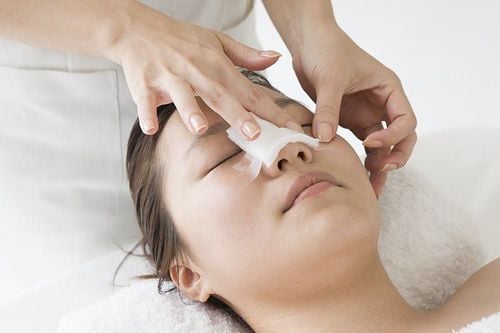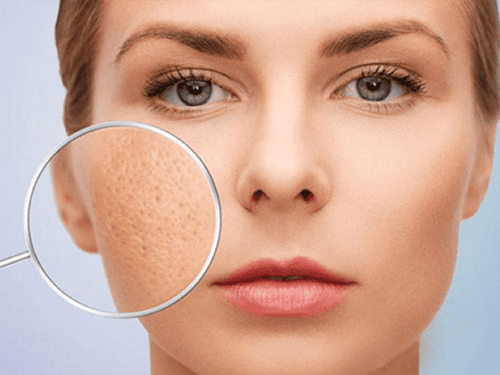This is an automatically translated article.
Many people have dry skin, while others have oily skin, there are also cases of both dry and oily skin. Dermatologists may refer to this skin condition as “combination skin.” Dry skin and oily skin are more common in people with chronic or genetic dehydration. Combination skin increases the risk of wrinkles appearing at the same time as acne, blackheads, and other oily skin-related problems.
1. Signs of a dry and oily skin
Before you start taking steps to treat combination skin, it's important to know if you really have this skin type. Here are some signs of combination skin. If in doubt, see a dermatologist for a definitive diagnosis:
Oily T-zone: The skin on your nose, chin, and forehead is oily or shiny. This area is called the T-zone. Enlarged pores: You can easily see your pores in the mirror, especially the pores on the forehead, nose and sides of the nose. Dry skin spots: Your cheeks and skin under your eyes are often dry (and sometimes scaly). If you are not sure if the above symptoms are really present, do a simple test like this:
Wash your face thoroughly with soap or a mild cleanser; Pat the skin dry with a soft cotton towel and wait 20 minutes; Do not touch your face during this time or put anything on your face (such as moisturizer); After 20 minutes have passed, look at your skin in the mirror. If your T-zone is oily but the rest of your face feels instantly tight, you probably have combination skin. “If over-the-counter skin care products aren't meeting the goals you're looking for, make an appointment with a board-certified dermatologist for expert help," advises Zeichner. You should also see a dermatologist if you're having trouble controlling skin problems like acne. The dermatologist will examine your skin closely, magnifying certain areas and gently touching them. In addition, the doctor may also ask questions about your current lifestyle and skin care regimen. All of this information will be a suggestion for the dermatologist to build a skin care and treatment program that is suitable for each individual.
2. Causes of both dry and oily skin
"Your skin type is determined genetically," says Joshua Zeichner, MD, director of cosmetic and clinical research in dermatology at Mount Sinai Hospital in New York. And according to Tanya Kormeili, MD, a board-certified dermatologist in Santa Monica, California, "we can't actively change our skin type."However, in addition to genetic factors, some external environmental factors such as the aging process and hormonal fluctuations can cause skin changes. As you age, your skin usually becomes drier and produces less oil. Hormonal factors, like your period and birth control pills, can also affect your skin. Also, your current diet, weather and skin care routine - especially if you're using topical products.

Điều quan trọng vẫn là duy trì việc dưỡng ẩm cho da của bạn
3. Treatment of dry skin, oily skin
Although genetics is the leading factor in determining your skin type, there are many possible ways to deal with dry, oily skin problems, specifically:
Skin nutrition: Many times People with dry skin combined with oily skin often develop breakouts due to moisturizers or lotions. However, it is still important to keep your skin hydrated. You can add moisture to your skin by incorporating healthy oils into your diet or taking a fatty acid supplement, such as fish oil with docosahexaenoic acid (DHA) and eicosapentaenoic acid (EPA) and plant sources of alpha-linolenic acid (ALA). Use an oil-free sunscreen: Always use sunscreen whenever exposed to the sun. However, this makes it difficult for many people with dry and oily skin because they fear sunscreen will cause breakouts. So an oil-free sunscreen is a safe choice. They are often labeled as "mineral sunscreens". Medication: Your dermatologist may prescribe medication to control your skin, usually in the form of a topical treatment. Topical prescription retinol or benzoyl peroxide can be used to unclog pores and control breakouts. However, it is important to avoid applying them to areas of dry skin. Meanwhile, corticosteroids are indicated to reduce itching and inflammation, which often accompanies dry skin. Remember, patience is key when it comes to combination skin care. Finding a suitable routine can be difficult and it can take a month or two before any visible results are seen. But using the right products in the right areas, morning and night, will help keep your skin in the best shape possible. If you feel like things aren't going the way you expected, you might consider making an appointment with a dermatologist.
Please dial HOTLINE for more information or register for an appointment HERE. Download MyVinmec app to make appointments faster and to manage your bookings easily.
Reference source: healthline.com












